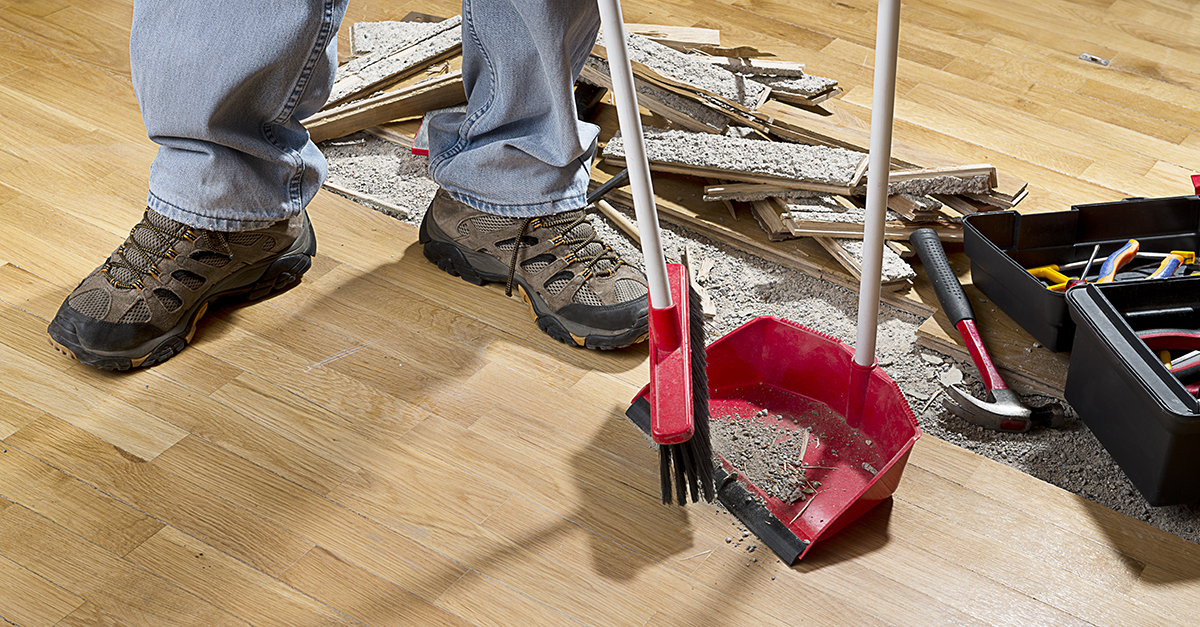Unlike standard janitorial services, construction cleanup requires attention to every surface. From drywall dust to large sawdust and paint-splatter, there’s a wide range of service to implement.
Keep in mind that initial steps involve removing debris before getting down to surface cleaning. Due to the nature of drywall dust, literally every surface has to be considered: Walls, light fixtures, and window frames and sills. In some cases, even ceiling surfaces demand cleaning. It can be a massive job.
You will probably hear the following fibs from the client whose building you are servicing:
- Fiction No. 1: You will be the last contractor through the building. After three decades, I have yet to see this happen. Cleaning contractors typically have to clean, and then clean again after construction is complete.
- Fiction No. 2: You have five days to complete the cleaning. In fairness to construction companies, a lot of services go into developing a building. In my personal experience, no construction crew has finished the job when specified.
- Fiction No. 3: The area will be clear and empty for your service. This just never happens. Carpenters, plumbers, flooring installers, and electricians are all at work. Items may be left behind; cardboard boxes and pallets that shed debris are very common. After you clean around them and move them, there will be a dirty spot.
With these points in mind, here are 10 areas for outside contractors to consider to best prepare for a construction cleanup project:
1. Floor Care
Knowing what flooring materials you’re working on is a must. Using the incorrect process or materials can damage a flooring surface. No one wants to be responsible for creating these kinds of headaches.
Laminate flooring, luxury vinyl tile, and ceramic tile all have different care requirements. Grout will likely develop a haze during construction. This will require special attention with an acid cleaner.
2. General Contractors
One of your best choices is to stay in close and friendly contact with the general contractor. As other contracted specialists are in the space, cleaning services staff will be interacting with a lot of people. Remember that regardless of when construction is complete, your cleanup deadline will have a fixed end date and will not change.
3. Timing
Let’s assume the project specifications provide “five days to service the building with a crew of 10,” and the job is due on the 30th of the month; however, by the 25th, the construction isn’t complete. Most likely, the lost days that you originally allotted to complete the job will be taken from the cleaning schedule. That’s the truth.
Now, let’s say you end up with three days to clean instead of five. You now have new questions to answer: Will your crew of 10 still be able to complete the job on time? Will adding more hours to each of the three remaining days be enough? If you need to add more personnel, are they trained and available? Perhaps most importantly, are they adaptable?
4. Documentation
A punch list is a follow-up list for the commercial cleaner after the cleanup is complete. These items can vary from a missed area to a new cleanup duty as a result of another contractor. For example, if an electrician adds a wall outlet, he will cut a hole, leaving a small amount of debris. The cleaner probably won’t miss it during the initial cleanup process, but if it was added late in the game, it will show up on the punch list as a to-do item.
For this reason, documentation is extremely important. For each shift, have the general contractor perform a walk-through with a check list of required cleaning tasks. This doesn’t mean repeat work will disappear; however, your work will be verified. Take pictures of completed areas. In the event you need to charge for additional hours, good documentation is the best defense.
Additionally, if the general contractor requests something you advise against, have them sign off on your recommendations. Should there be any issues after the fact, you will have documentation of your recommendation to back you up.
5. Timing and Leadership
Understand that construction cleanup will require physical and mental agility. There will be surprises. If you are mentally prepared, those will become less daunting. In addition, providing strong leadership to your crew and having an open working attitude toward the general contractor can help ease tensions.
In some cases, contractors in the space will create work for the cleaning crew. Prepare your cleaning crew for this. In the event this occurs, they should know to bring the issue to the cleaning crew leader, so he/she can work it out, instead of instigating a conflict with the contractor.
6. PPE
Be sure your crew is familiar with all personal protective equipment (PPE) and risk factors. Note the potential existence of silica from concrete and other airborne debris, and be sure to put respirators through a fit test. This will ensure that your crew is trained and familiar with this equipment.
Safety glasses, nitrile gloves, and dust masks are a given in construction cleanup jobs (see our article on PPE). If construction cleanup is performed in the evening, bright reflective vests are also strongly suggested. Use leather gloves in the event of moving heavy equipment or pallets. Other items include hard hats, steel-toed shoes, and full-length pants.
7. Other Safety Factors
We see a steady increase of cleaning crew members who want to listen music during their service. On sites where we perform construction cleanup, this is strictly forbidden. The ability to hear what’s going on around you is a matter of personal safety.
Make sure all staff are ready to act at a moment’s notice. Instructyour cleaning staff on the contents of your first-aid kit and proper use of the supplies in it. Last, construction cleanup is hard work – stay hydrated.
8. Training
This begins with training yourself and then your staff. ISSA’s Cleaning Management Institute (CMI) is excellent for these needs. You will need a plan in place to address emergency needs should they arise.
When working in large spaces with high ceilings or racking, cleaning takes on a new dimension. The cleaning contractor will need to ensure that staff members have passed training for working on lifts, and tying off areas for safety tethers.
9. Insurances
Before submitting your bid on construction cleanups, speak with your insurance carrier. Some services may be outside your scope of coverage. There are options, but doing so without the proper insurances can put you at astronomical financial and personal risk.
10. Create Solutions
Should you have an area that’s ready before others and can be closed off, tape off the doorway and mark it as “cleaned” to signify that you are done in that space and have honored the general contractor’s request.
More than Cleaning
Most importantly, remember: You’re working with people. Whether you are dealing with your crew or the general contractor, everyone is working to get the job done.
Every general contractor has their own personality. Get to know who you’re working with, as positive interaction with the general contractor can set the tone for the entire service. Understanding who they are will help you complete your service with as little friction as possible.



